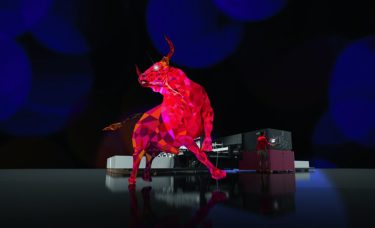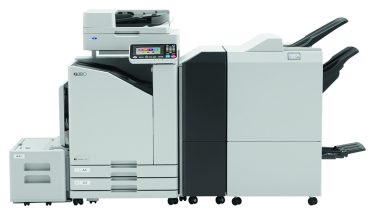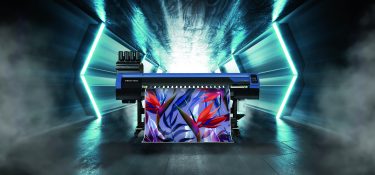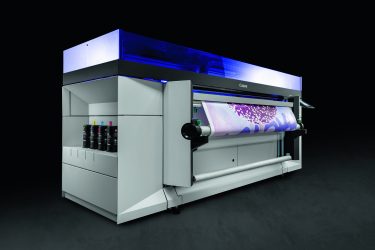Despite opening with stringent pandemic restrictions in place in much of the world, there were still plenty of technology introductions and highlights in 2021, says Michael Walker
While we emerged from lockdown and made our way to as much normality as we could, the industry kept pace, continuing with product introductions and new developments, some still arising from the postponed drupa momentum, and others that would not have made it there anyway. Here’s an overview.
EFI opened the batting for the season with a brace of fast wide-format printers announced at the online version of its Connect event. Topping the chart in raw speed terms was a new single-pass graphics printer capable of 1000 8×4 boards an hour, though it can print sheets of up to 1.6 x 3m. It offers optional orange, violet and white inks and is said to offer the lowest cost per unit of output.
At a ‘mere’ 375 boards an hour, the new Vutek XT hybrid also focuses on lowering total cost of ownership and was said to get similar image quality to eight-colour units out of just four process colours. The Pro 32h hybrid offers up to 230sqm/hr across 3.2m and up to five layers in a single pass, retailing for under US $200,000. On the roll-fed side, EFI introduced the Q3r and Q5r, three- and five-metre UV machines with a choice of inks for vivid display colours or flexibility for vehicle wraps.
Later in the year, EFI also debuted the entry-level Pro 30h hybrid wide-format printer, offering resolutions up to 1200dpi and speeds of up to 230sqm/hr, with options for white and clear inks and the ability to print up to five layers in a single pass.
Duplo offered the 150 Booklet System, combining the existing DSC-10/60 feeder with its DBM-150 Booklet Maker and Trimmer, allowing a wide range of sizes and stock weights to be handled. This was followed in March with the introduction of the DF-1300L, a folder aimed specifically at the long sheet sizes supported by many SRA3 digital presses, able to handle sheets up to 311 x 748mm and up to 230gsm. It offers a variety of folding options, including for six-panel A4 tri-fold leaflets and landscape orientation A4 brochures.
The company also took on distributorship for the Ultra C range of UV, aqueous and soft-touch flood coaters, whichit is promoting as an environmentally-friendly alternative to lamination of digital print, including food packaging.
Riso introduced the ComColor FT range of A3 and A4 sheet-fed inkjet printers, offering 600 x 600dpi on stocks up to 400gsm via optional accessories, with inline finishing including folding, stacking and booklet-making.
Ricoh added a Pro Scanner option for its VC60000 and VC70000 web inkjet presses, allowing on-the-fly image quality and registration assessment and correction; an option for checking each printed page against artwork files was also introduced.

Agfa’s Jeti Tauro H3300 UHS accelerated to 600sqm/hr
Agfa brought out the fastest version yet of its Jeti Tauro hybrid LED UV printer, the H3300 UHS, able to hit 600sqm/ hr across media up to 3.3m wide, 30% faster than the original model and supporting the same automation options. It’s aimed at the high end of the signage and display market but is also suitable for printing on corrugated board, suggesting packaging and PoS applications. The company also opened a new UK showroom in Rugby in March.
This was followed in June with the launch of the Avinci CX3200, a 3.2m dye-sub printer able to print to transfer paper or directly to fabric at up to 270sqm/hr, suiting soft signage applications including banners, wall graphics and flags.
Canon began a busy year with the launch of the 70ppm SRA3 toner ImagePress C170 line, aimed at in-house/ CRD applications, plus a later update to the ImagePress CV10010VP production model, which gained a registration and colour accuracy sensing unit, as well as updating its ImagePrograf printer/plotters. This was followed by the introduction of the ColorStream 8000 web inkjet press, aimed at transpromo, DM and pharma printing, at up to 160m/min.
On the wide-format side, Canon introduced an entry level version of its UV-gel roll printer, the Colorado 1630, which runs at 70% of the speed of existing 1640/1650 models and has remotely unlockable upgrades. The Arizona flatbed line got a mid-summer boost with the addition of the entry-level 135GT, a 1.25 x 2.5m LED curing UV printer, available for around €69,000, that can also be upgraded to support roll-to-roll work.
Xeikon followed up 2020’s debut of the ‘Sirius’ technologybased SX30000 web toner press with a smaller sibling, the 30m/sec SX20000, which offers the equivalent of 1700 B2sph. It handles the same stock weights and widths, prints at the same 1200 x 3600dpi resolution and can be upgraded for both speed and from four colours to five. Target applications for the SX20000 include books and direct mail.
The company also opened a virtual wall décor centre to showcase applications of its presses in this sector, expected also to appeal to architects, interior designers and retailers, and in April, added the CX50, a dedicated wall decoration toner press, as part of its Well Deco Suite. The CX50 is the middle option in productivity terms, between the 3050 Rex entry-level model and the CX500 press, and can be upgraded from 20 to 30m/min.

Riso extended its sheet-fed inkjet range with the ComColor FT models
HP added four 1.6m Latex printers to its eponymous line, the 700/800, each available with white ink, and offering up to 36sqm/hr depending on quality and application. Its print and cut line of stand-alone or linkable cutters was also updated, as was the Stitch 1000 dye-sub printer which gained better colour saturation in direct-to-fabric printing mode. New 1.6m photo printers were added to the HP DesignJet line in the autumn, the ZPro and Z9+ Pro, offering up to nine colour plus gloss. Three 1m-width PageWide machines for poster printing were added at the same time.
Mutoh added two 1.6m printers, the roll-fed ValueJet 1638UR Mk II and the hybrid 1628UH Mk II, able respectively to handle rolls up to 100kg and rigid media up to 15mm thick and weighing 15kg. Both support CMYK plus white and clear or double CMYK for increased productivity of up to 22.7sqm/hr. These were followed up in April with the addition of the XpertJet 1628WR, a dye-sub model based on the same 1.6m chassis, supporting up to eight colours and offering production at up to 48sqm/hr. Mutoh’s autumn season included the XPJ-1642WR, again based on the XpertJet 1.6m platform, but this time a dyesub transfer paper printer with water-based inks said to give improved quality on any sublimation-capable substrate and better productivity, with ‘sellable’ print at up to 61sqm/hr.
Horizon introduced a fully automated eight-buckle folder, the AF-408F, aimed at pharma and other small leaflet production. It accepts sheets up to 900mm in length (via an optional extension) and can space folds at 20mm. This was complemented later in the year by the AFV-566FKT, an automated cross-folder designed to support digital print shops where short runs are common, by offering 20% quicker changeovers than its predecessor.
Wide-format printer manufacturer swissQprint introduced a faster and more automated version of the Karibu roll-fed printer launched in 2019. The 3.4m Karibu S offers up to 330sqm/hr and a double-sided printing capability now is available both for it and original Karibu models via a retrofit. Two new ‘neon’ inks, yellow and pink, which fluoresce under UV light, were launched, and are offered for all the company’s printers.
Mimaki expanded its textile printer range, with the entry level 1.6m TS100-1600 dye-sub running at up to 70sqm/hr being complemented by the industrially-focused 1.8m Tiger 1800B Mk III, which supports a variety of ink types for different fabrics and gains improved reliability and accuracy. Both are driven by the TxLink4 Rip software which has textiles-specific functionality.
These were complemented a month or so later by the introduction of the JFX 550-2513 and 600-2513, high productivity 2.5 x 1.3m flatbeds offering up to 16 printheads and 200sqm/hr, plus a dedicated 1.6m roll-fed leather printer, the SUJV-160, that uses a special inkset developed by Fujifilm and which includes a clear ink. In the autumn, four new models were added to Mimaki’s direct-to-object printer range, most of them in a new smallformat/desktop line.

Mimaki’s entry-level dye-sub printer, the 1.6m TS100-1600
Late spring saw Ricoh reveal some of the specifications of its long-teased B2 digital press, revealed as the Pro Z75, a 4500sph (simplex) aqueous inkjet that is aimed squarely at the commercial sector, with a duty cycle around 1.25 million impressions a month and with greater media flexibility than most inkjets. Beta testing should be well underway by now, but commercial availability isn’t expected until Q2 of 2022.
Ricoh also reached an agreement with Austrian direct-togarment developer Aeoon Technologies to extend its DtG offering into the higher productivity sectors of this market.
Around the same time high performance wide-format printer specialist Durst introduced a dye sublimation version of its P5 roll-fed printer platform the P5 Tex iSub, a 3.3mmodel that can print directly to suitable polyesterbased fabrics within inline heat fixation, or to thermal transfer paper. It runs at up to 383sqm/hr and additional primary colour inks are available.
Fujifilm introduced a faster version of its established JetPress B2 inkjet, the 750 High Speed, which trades resolution for speed to hit 5400sph (simplex); the 2600sph of the existing model is also supported in ‘high quality’ mode. The faster mode also dispenses with the priming stage that is otherwise used, which may limit the choice of papers that can be used at top speed.
Following the ending of its OEM agreement with Canon for flatbeds, Fujifilm introduced its first own-build model, the Acuity Prime, a 2.5 x 1.7m UV printer that supports white and clear ink in addition to CMYK. The Acuity Ultra R2 roll-fed printer was also introduced, an upgrade to the 3.2 and 5m models launched in 2018 with various usability and overall productivity enhancements.
April saw Epson expand the top end of its textile printing line with the introduction of the SureColor F10070H, an industrial strength 1.9m dye-sub printer claimed by the Japanese company to be cheaper than competitors in this sector.
The end of that month also saw Vivid add a B1 format version of its VeloBlade cutting table, in response to customer requests. Also in the finishing arena, a couple of weeks later, CreaseStream and ProCut introduced FoldStream, a crease-and-fold system able to handle digital print without damage at up to 10,000 items per hour, up to SRA3 size and 400gsm or more and without some of the issues experienced with plate or buckle folding.
In May, Inca Digital and Fujifilm introduced a range of robotic automation options for the former’s OnsetX HS range of high performance flatbed printers, from semi- to fully automatic loading and unloading of boards, allowing overall throughput to be increased.

Canon brought out an entry-level version of the Colorado, the 1630
June saw the arrival of Konica Minolta’s C7100/7090 toner presses that offer 100/90ppm with a variety of automation and quality control feature and completed the revamp that began with the 2019 introduction of the high-end C14000, some of whose features made their way into the new midrange machines, including a new toner – though the August explosion in the company’s Tatsuno factory in Japan has caused ongoing problems with toner supply.
That month also saw the newly independent Kongsberg PCS add the C20, a compact 1.6 x 1.4m cutting table to its C Series, with which it shares features aimed at increased accuracy and consistency.
One of the big stories of the summer was the acquisition by Global Graphics of packaging design and workflow developer Hybrid Software, which doubled the group’s size and turnover; the company subsequently rebranded as Hybrid Software Group and in late October acquired German colour management developer ColorLogic to extend its capability in multi-colour / extended gamut packaging print production.
The autumn saw a further flurry of introductions, with Kodak launching the Ascend, a five-colour toner press aimed at PoP / PoS and small packaging applications, a 120ppm press that can also handle long sheets to 1.2m and stocks up to 762microns thick. A wide range of special fifth colours will be available. The company also announced a web browser-based version of its Prinergy on Demand workflow offering that brings the established workflow within range of smaller print shops. Both the press and the software will be available in 2022.
Morgana held one of the first in-person events of the year with a mid-September open house at its Milton Keynes headquarters, at which Premier and Konica Minolta / MGI participated, showing a complete packaging production line. It also showcased the new Docubind Pro VFX twin-wire binder for lay-flat products.
Another event that went ahead was Fespa, which was used by Roland DG to introduce the VersaStudio BN20A entry-level print-and-cut device, suitable for stickers, labels and heat transfer sheets for garment printing. The company also upgraded and reopened its Danish and UK showrooms.
Screen didn’t introduce any major new products under its own name. However in late November it did announce a partnership, encompassing both the USA and Europe, with envelope converting and inserting specialist Winkler+Dünnebier to sell complete direct mail systems built around the TruepressJet 520 web inkjet press and W+D’s equipment.





